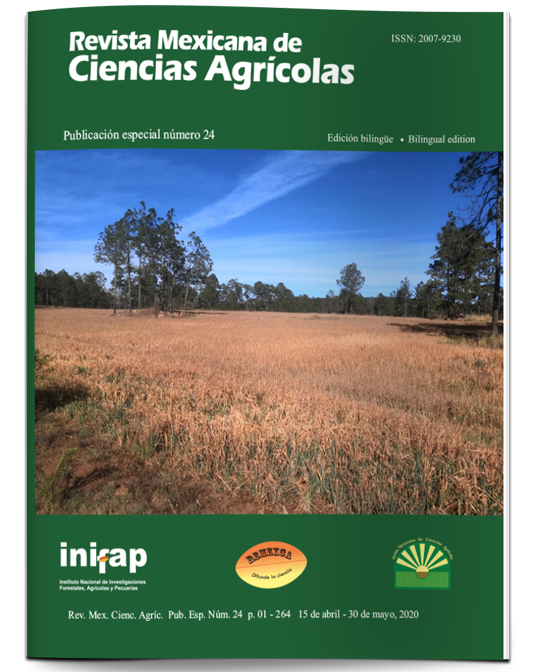Forage evaluation of maize from various origins of Mexico in the semi-arid region
DOI:
https://doi.org/10.29312/remexca.v0i24.2361Keywords:
Zea mays L., creoles, forage, morphological componentsAbstract
The aim was evaluating the productive behavior of 21 genotypes of forage maize of different origins and seeing their adaptation in semi-arid areas in Soledad de Graciano Sanchez, SLP, at 22.22° north latitude and 100.85° west longitude at 1 835 masl. In temperate dry climate with an average temperature of 17.1 °C and precipitation of 362 mm. In 21 corn genotypes of different regions, the Plant Height (PHeight), Number of leaves per plant (NLeaves), Stem diameter (Diameter), Height of the first corn (EHeight), Foliar area of the corn leaf (FACL), Number of corn (NCorn), Yield of dry matter of the plant (YDMP), of leaf (YDML), of stem (YDMS) and of corn (YDMC), Relationships Leaf: Plant (RLP), Stem: Plant (RSP), Corn: Plant (RCP); Neutral Detergent Fiber (NDF) and Acid (ADF). The experimental design was completely randomized with six replications. The Tlaha2 genotype showed the highest value of PHeight with 2.5 m and EHeight with 1.4 m. Tampiqueño1 showed the highest NLeaves with 13.6. Chalqueño showed the largest diameter with 4.1 cm and the greater FACL with 775.97 cm2. Papjalb/a, AS948-2 and Gdelfin showed the highest number of corns with 1.5 pl-1 corn. Chalqueño and Tampiquelo1 showed the highest YDM values with 46 246 and 42 947 kg DM ha-1, respectively. It is concluded that there are genotypes from other regions that adapt to the dry climate of semi-arid areas and produce higher RMS and with better morphological components than other creoles and that the recommended improved varieties.
Downloads
Downloads
Published
How to Cite
Issue
Section
License
The authors who publish in Revista Mexicana de Ciencias Agrícolas accept the following conditions:
In accordance with copyright laws, Revista Mexicana de Ciencias Agrícolas recognizes and respects the authors’ moral right and ownership of property rights which will be transferred to the journal for dissemination in open access. Invariably, all the authors have to sign a letter of transfer of property rights and of originality of the article to Instituto Nacional de Investigaciones Forestales, Agrícolas y Pecuarias (INIFAP) [National Institute of Forestry, Agricultural and Livestock Research]. The author(s) must pay a fee for the reception of articles before proceeding to editorial review.
All the texts published by Revista Mexicana de Ciencias Agrícolas —with no exception— are distributed under a Creative Commons License Attribution-NonCommercial 4.0 International (CC BY-NC 4.0), which allows third parties to use the publication as long as the work’s authorship and its first publication in this journal are mentioned.
The author(s) can enter into independent and additional contractual agreements for the nonexclusive distribution of the version of the article published in Revista Mexicana de Ciencias Agrícolas (for example include it into an institutional repository or publish it in a book) as long as it is clearly and explicitly indicated that the work was published for the first time in Revista Mexicana de Ciencias Agrícolas.
For all the above, the authors shall send the Letter-transfer of Property Rights for the first publication duly filled in and signed by the author(s). This form must be sent as a PDF file to: revista_atm@yahoo.com.mx; cienciasagricola@inifap.gob.mx; remexca2017@gmail.
This work is licensed under a Creative Commons Attribution-Noncommercial 4.0 International license.



